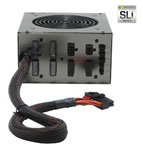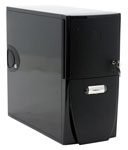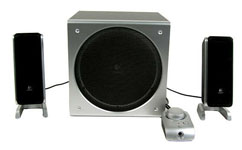Mid-Range Buyer's Guide, September 2005
by Jarred Walton on September 19, 2005 12:05 AM EST- Posted in
- Guides
Remaining Recommendations
We've covered the major components of the systems, and all that remains are the accessories. There isn't much new to say on the majority of these parts, and our Price Guides cover each area in more detail. Here are the rest of the components, and for most of them personal preference will play a large part in determining what you get. If you want higher quality speakers, you'll need to spend more money. A faster hard drive (or multiple hard drives) is definitely an option, but for most people it won't have a major impact - we generally prefer storage capacity and low noise levels over a small increase in HDD performance. Case, power supply, and optical storage choices round out the final components.
We have two lists of the remaining parts, one for the gaming configurations and the other for the office setups. We tried to balance the final system cost as much as possible, but the simple truth is that a good gaming/enthusiast setup requires more expensive parts than a business configuration. You can always downgrade some of the components to cheaper alternatives, but if we were building a computer for our own use, we'd rather save up for better quality than settle for lower cost.
Gaming Components:
Office Components:
Most of the choices should be pretty self-explanatory, so we just want to touch on the important areas. First, we've chosen to use a higher end power supply for the gaming configuration. Many people think that the modular power supplies are nice as they help to eliminate cable clutter, though some of the cables are a little stiff and can be difficult to route. The SunBeam 550W that we've chosen includes two PCIe power connectors, which would be required for an SLI configuration. (If you're running high-end components in an SLI setup, we'd think twice about using simple molex-to-PCIe adapters.) $86 for a power supply is a lot of money, but that's better than having random system crashes caused by exceeding the PSU load levels. Antec, OCZ, Enermax, and a few others also have some SLI-ready power supplies, though most cost upwards of $100 (and we'd avoid anything claiming SLI readiness that costs under $75).
Both setups use pretty low-end speaker arrangements. The Z-3e speakers sound good for the price, but they're not at the level of something like the Z-5500 or Klipsch, and true audiophiles would scoff at either of those "high end" choices that we just mentioned. If you're serious about audio quality, you probably already know more than what we typically cover in the Buyer's Guides. (The entire Logitech line of speakers is pretty reasonable if you're looking for other options. We've recommended them many times in the past, and this isn't really a change in recommendation so much as an alternative that you might consider.) We also stick with the integrated audio solutions for all of the systems, though the Karajan adapter of the DFI board certainly offers the best overall quality of the four boards. While there is a difference between integrated audio and discrete audio solutions, you'll need better speakers before it really begins to matter.
Our hard drive and optical drive selections are essentially a toss up. Our last Hard Drive Roundup showed that SATA 3.0Gbps drives were faster in some areas, NCQ could help out in certain tests as well, but there was no clear victor. All things being equal, we'll go for cost per GB, and for the dual-core systems, we'll also grab an NCQ enabled drive. Some people would rather have a better warranty like the 5-year Seagate and Western Digital Raptor or Caviar RE. If you ever need to use that warranty, though, you'll probably be pretty unhappy - the data on the drive is almost always more important than the drive itself. That's why a good backup strategy is important, and the DVDR drives that we've listed will get you started. We should also mention that firmware updates to the NEC 3540A and BenQ DW1640 drives have ironed out most of the media compatibility issues, so either drive is a good purchase.
We've covered the major components of the systems, and all that remains are the accessories. There isn't much new to say on the majority of these parts, and our Price Guides cover each area in more detail. Here are the rest of the components, and for most of them personal preference will play a large part in determining what you get. If you want higher quality speakers, you'll need to spend more money. A faster hard drive (or multiple hard drives) is definitely an option, but for most people it won't have a major impact - we generally prefer storage capacity and low noise levels over a small increase in HDD performance. Case, power supply, and optical storage choices round out the final components.
We have two lists of the remaining parts, one for the gaming configurations and the other for the office setups. We tried to balance the final system cost as much as possible, but the simple truth is that a good gaming/enthusiast setup requires more expensive parts than a business configuration. You can always downgrade some of the components to cheaper alternatives, but if we were building a computer for our own use, we'd rather save up for better quality than settle for lower cost.
 |
 |
 |
| Click images to enlarge. | ||
Gaming Components:
| Hard Drive: | Western Digital SATA II 160GB 7200RPM 8MB Caviar SE | $81 |
| Optical Drive: | BenQ DW1640 Black (OEM) | $43 |
| Case: | Cooler Master Cavalier 3 CAV-T03-UK | $76 |
| Power Supply: | SunBeam 550W NUUO SUNNU550-US-BK Modular PSU | $86 |
| Speakers: | Labtec ARENA 685 5.1 Speakers | $48 |
| Keyboard and Mouse: | Logitech Internet Pro Desktop | $23 |
 |
 |
 |
| Click images to enlarge. | ||
Office Components:
| Hard Drive: | Hitachi SATA 250GB 7200RPM 8MB Deskstar 7K250 NCQ | $120 |
| Optical Drive: | NEC 3540A Black (OEM) | $42 |
| Case and Power Supply: | Antec Sonata II + SmartPower 2.0 450W PSU | $115 |
| Speakers: | Logitech Z-3e 2.1 Speakers | $73 |
| Keyboard and Mouse: | Logitech Internet Pro Desktop | $23 |
Most of the choices should be pretty self-explanatory, so we just want to touch on the important areas. First, we've chosen to use a higher end power supply for the gaming configuration. Many people think that the modular power supplies are nice as they help to eliminate cable clutter, though some of the cables are a little stiff and can be difficult to route. The SunBeam 550W that we've chosen includes two PCIe power connectors, which would be required for an SLI configuration. (If you're running high-end components in an SLI setup, we'd think twice about using simple molex-to-PCIe adapters.) $86 for a power supply is a lot of money, but that's better than having random system crashes caused by exceeding the PSU load levels. Antec, OCZ, Enermax, and a few others also have some SLI-ready power supplies, though most cost upwards of $100 (and we'd avoid anything claiming SLI readiness that costs under $75).
Both setups use pretty low-end speaker arrangements. The Z-3e speakers sound good for the price, but they're not at the level of something like the Z-5500 or Klipsch, and true audiophiles would scoff at either of those "high end" choices that we just mentioned. If you're serious about audio quality, you probably already know more than what we typically cover in the Buyer's Guides. (The entire Logitech line of speakers is pretty reasonable if you're looking for other options. We've recommended them many times in the past, and this isn't really a change in recommendation so much as an alternative that you might consider.) We also stick with the integrated audio solutions for all of the systems, though the Karajan adapter of the DFI board certainly offers the best overall quality of the four boards. While there is a difference between integrated audio and discrete audio solutions, you'll need better speakers before it really begins to matter.
Our hard drive and optical drive selections are essentially a toss up. Our last Hard Drive Roundup showed that SATA 3.0Gbps drives were faster in some areas, NCQ could help out in certain tests as well, but there was no clear victor. All things being equal, we'll go for cost per GB, and for the dual-core systems, we'll also grab an NCQ enabled drive. Some people would rather have a better warranty like the 5-year Seagate and Western Digital Raptor or Caviar RE. If you ever need to use that warranty, though, you'll probably be pretty unhappy - the data on the drive is almost always more important than the drive itself. That's why a good backup strategy is important, and the DVDR drives that we've listed will get you started. We should also mention that firmware updates to the NEC 3540A and BenQ DW1640 drives have ironed out most of the media compatibility issues, so either drive is a good purchase.










56 Comments
View All Comments
flatblastard - Tuesday, September 20, 2005 - link
I'll be looking forward to reading this article, maybe we can clear some of this confusion up.ksherman - Monday, September 19, 2005 - link
you mentioned that XP Pro will have no problem with a dual core processor. If I were to upgrade my current computer with a 3800+, will I have to reinstall my OS? everything else will remain constant.JarredWalton - Monday, September 19, 2005 - link
It depends in a large part on your current setup. Worst case scenario, you'd probably have to do a repair installation over your current OS. Actually, worst case you hose your current OS and start from scratch, but 99% of the time that's not required.Furen - Monday, September 19, 2005 - link
You are very likely to be able to pull off a CPU swap without problems but if you have those weird speed-up/slow-down problems that some people seem to be having in certain games (and you cant fix them using the X2 driver), then a clean install will probably fix that for you.2ndRUNNER - Monday, September 19, 2005 - link
I would rather buy an entry-level PC for doing most of my jobs
and save $400 or more (on graphic, SLI mobo, CPU, etc.)
to buy a console dedicated to pure gaming. In this way, I can
enjoy the best of both worlds since all major game companies
are moving to consoles. In addition, I feel more comfortable
watching DVD, seeing my photos, listening to music, recording
TV programs and definitely, playing games with friends on my sofa.
yacoub - Monday, September 19, 2005 - link
Hmmm let's see:I like to watch TV while I use the computer. I can't play a console and watch TV as easily, let alone hear the news in the background while I play.
My TV is too old to really provide a worthy display for a modern console. So that means spending $1000-2000 for a nice TV.
I tend to prefer PC games for their greater depth, functionality (due to more buttons to bind and flexibility in how you assign them), modability, map/level-making, community, etc. Many things not offered on console games.
Until there is a trackball for controlling 'mouselook', a console controller is rubbish for FPS gaming, period.
A lot of the games I play today are older games that definitely won't be seen on a console anytime soon or simply wouldn't port well anyway due to their complexity (MechWarrior4:Mercenaries w/ MekTek add-on, MechCommander2 w/ Wolfman's add-on, Rome: Total War, etc).
So why would I: Give up the gaming I have now (my current rig needs an upgrade soon in order to continue gaming on it, so if I buy a console and TV I'm foregoing that), buy into an expensive proposition for future gaming that likely won't include many of the games I'd be interested in, and thus end up with less than what I started?
It just doesn't make sense. Not yet. The XBox360 is coming closer, for sure, but until they provide a trackball & keyboard setup including button configuration (heck, let me use my current USB ones from my PC) and content-identical ports of PC games, I won't be sold on using a console for ALL of my gaming wants.
yacoub - Monday, September 19, 2005 - link
Oh and then there's the realization that the Z-680s probably won't cut it for audio output for the TV and it'd be home theatre audio system time. Yeah right. That's so far out of my budget right now...bob661 - Monday, September 19, 2005 - link
The Z-5500's work perfectly for home audio use. There's an optical input on the controller. Works great.yacoub - Tuesday, September 20, 2005 - link
Yes, they're the same as my Z-680s, I'm just saying that they are still PC speakers, not home audio quality speakers. Compared to the other PC speaker options, they're excellent, but they don't stack up to home audio, trust me.JarredWalton - Monday, September 19, 2005 - link
People obviously have differing tastes. Personally, I hate console controllers. I was over at a friend's place tonight and we tried Conker: Reloaded on the Xbox. The pathetic controls are just a great way to mask non-existent AI, as far as I can tell. If I spent a lot more time with consoles, I'd certainly improve, but I don't think I could ever reach the same skill level as a mouse/keyboard FPS player.That's somewhat beside the point, though, when I consider the games I actually play and enjoy the most. FPS games are great, but a good strategy game often lasts longer on my HDD than the latest FPS. Point to a console game that can compete with Civilization III. (Imagine trying to control such a game without a mouse....)
There's room for both types of gamers, and frankly I doubt I'll get any of the next gen consoles. They just don't appeal to *me*.